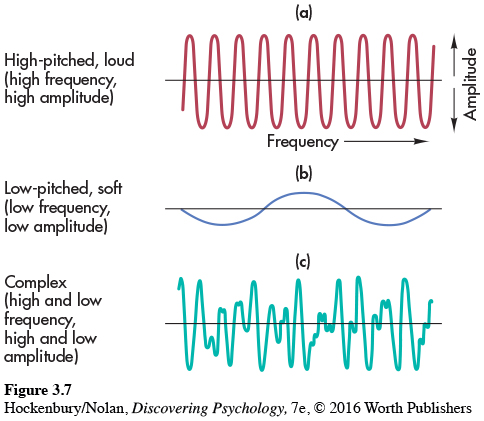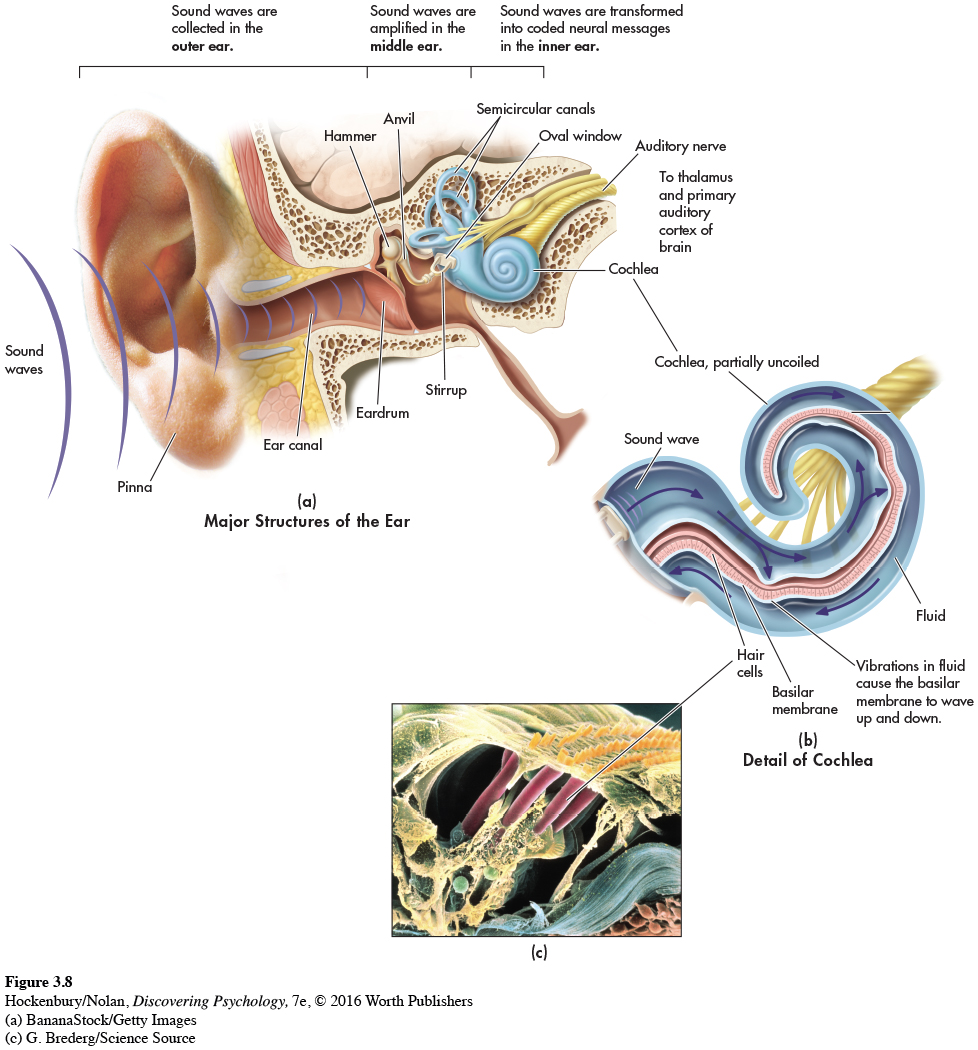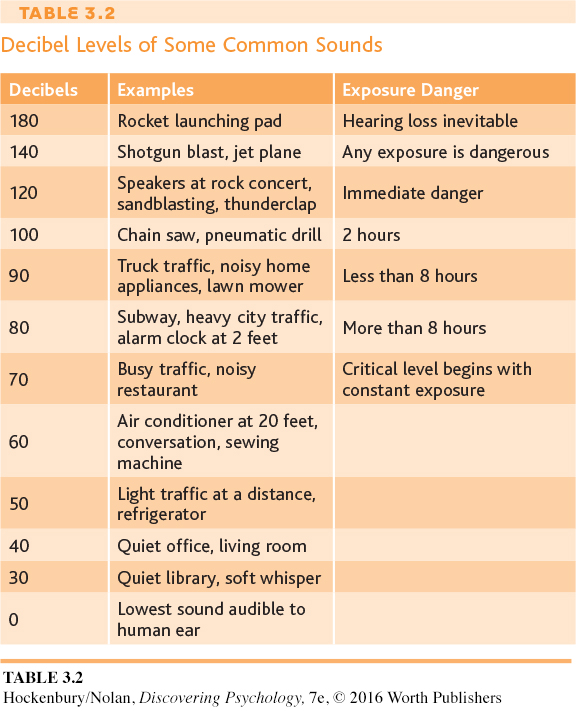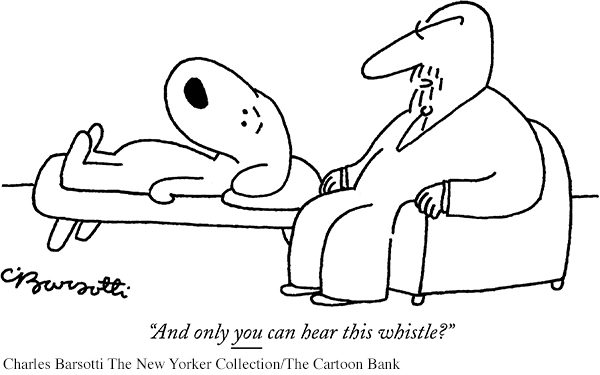HearingFROM VIBRATION TO SOUND
KEY THEME
Auditory sensation, or hearing, results when sound waves are collected in the outer ear, amplified in the middle ear, and converted to neural messages in the inner ear.
KEY QUESTIONS
How do sound waves produce different auditory sensations?
What are the key structures of the ear and their functions?
How do place theory and frequency theory explain pitch perception?
Your author Sandy has hiked in a desert area that was so quiet she could hear the whir of a single grasshopper’s wings in the distance. And she has waited on a subway platform where the screech of metal wheels against metal rails forced her to cover her ears.
The sense of hearing, or audition, is capable of responding to a wide range of sounds, from faint to blaring, simple to complex, harmonious to discordant. The ability to sense and perceive very subtle differences in sound is important to physical survival, social interactions, and language development. Most of the time, all of us are bathed in sound—
What We Hear
THE NATURE OF SOUND
Whether it’s the ear-

One of the first things that we notice about a sound is how loud it is. Loudness is determined by the intensity, or amplitude, of a sound wave and is measured in units called decibels. Zero decibels represents the loudness of the softest sound that humans can hear, or the absolute threshold for hearing. As decibels increase, perceived loudness increases.
Pitch refers to the relative “highness” or “lowness” of a sound. Pitch is determined by the frequency of a sound wave. Frequency refers to the rate of vibration, or number of waves per second, and is measured in units called hertz. Hertz simply refers to the number of wave peaks per second. The faster the vibration, the higher the frequency, the closer together the waves are—
Most of the sounds we experience do not consist of a single frequency but are complex, consisting of several sound-
How We Hear
THE PATH OF SOUND
The ear is made up of the outer ear, the middle ear, and the inner ear. Sound waves are collected in the outer ear, amplified in the middle ear, and transduced, or transformed into neural messages, in the inner ear (see Figure 3.8 below).

The outer ear includes the pinna, the ear canal, and the eardrum. The pinna is that oddly shaped flap of skin and cartilage that’s attached to each side of your head. The pinna helps us pinpoint the location of a sound. But the pinna’s primary role is to catch sound waves and funnel them into the ear canal. The sound wave travels down the ear canal and then bounces into the eardrum, a tightly stretched membrane. When the sound wave hits the eardrum, the eardrum vibrates, matching the vibrations of the sound wave in intensity and frequency.

The eardrum separates the outer ear from the middle ear. The eardrum’s vibration is transferred to three tiny bones in the middle ear—
Like the eardrum, the oval window is a membrane, but it is many times smaller than the eardrum. The oval window separates the middle ear from the inner ear. As the oval window vibrates, the vibration is next relayed to an inner structure called the cochlea, a fluid-
As the fluid in the cochlea ripples, the vibration in turn is transmitted to the basilar membrane, which runs the length of the coiled cochlea. Embedded in the basilar membrane are the sensory receptors for sound, called hair cells, which have tiny, projecting fibers that look like hairs. Damage to the hair cells or auditory nerve can result in nerve deafness. Exposure to loud noise can cause nerve deafness (see Table 3.2). Hearing aids are of no use in this form of deafness because the neural messages cannot reach the brain. However, nerve deafness can, in some cases, be treated with a cochlear implant, which is an electronic device surgically implanted behind the ear (see photo).


The hair cells bend as the basilar membrane ripples. It is here that transduction finally takes place: The physical vibration of the sound waves is converted into neural impulses. As the hair cells bend, they stimulate the cells of the auditory nerve, which carries the neural information to the thalamus and the auditory cortex in the brain (Hackett & Kaas, 2009; Recanzone & Sutter, 2008).
DISTINGUISHING PITCH

Collection/The Cartoon Bank
How do we distinguish between the low-
According to frequency theory, the basilar membrane vibrates at the same frequency as the sound wave. Thus, a sound wave of about 100 hertz would excite each hair cell along the basilar membrane to vibrate 100 times per second, and neural impulses would be sent to the brain at the same rate. However, there’s a limit to how fast neurons can fire. Individual neurons cannot fire faster than about 1,000 times per second. But we can sense sounds with frequencies that are many times higher than 1,000 hertz. A child, for example, can typically hear pitches ranging from about 20 to 20,000 hertz.
So how can higher-
The volley principle holds that hair cells also fire in “volleys.” Imagine three groups of neurons, each of which can fire at a rate of 1,000 times per second. But rather than firing in unison, the neuron groups take turns, each group firing in rapid succession while the other groups are in the resting state. In this way, impulses can be sent to the brain at rates that exceed 1,000 impulses per second.

So how do we hear higher-
Both frequency theory and place theory are involved in explaining our discrimination of pitch (Kaas & others, 2013). Frequency theory helps explain our discrimination of low frequencies. Place theory helps explain our discrimination of higher-